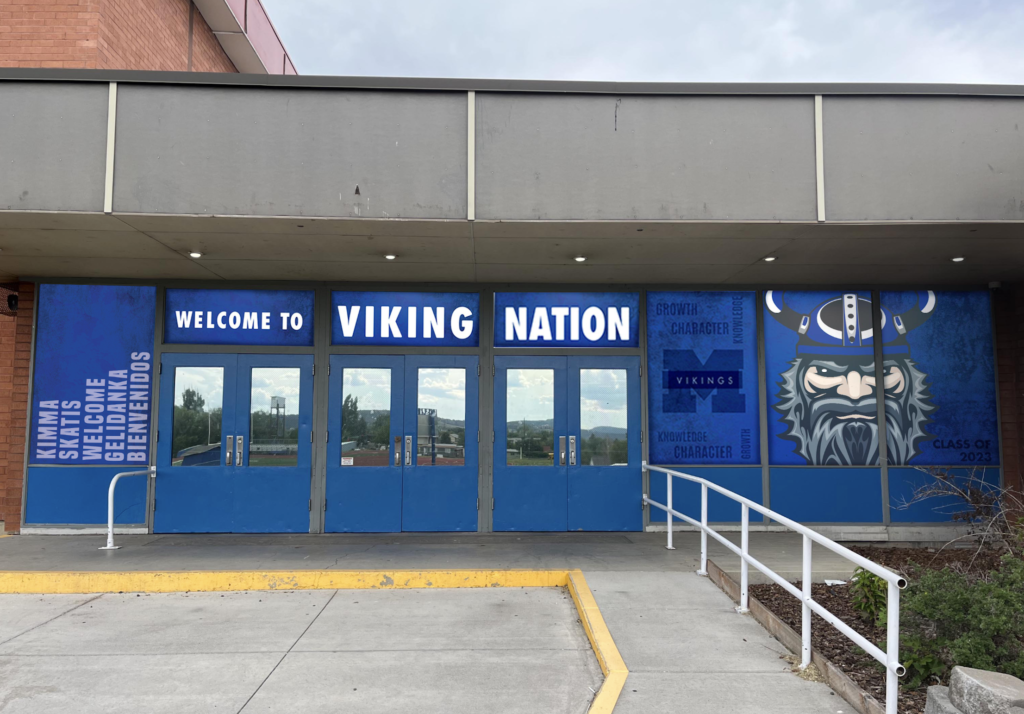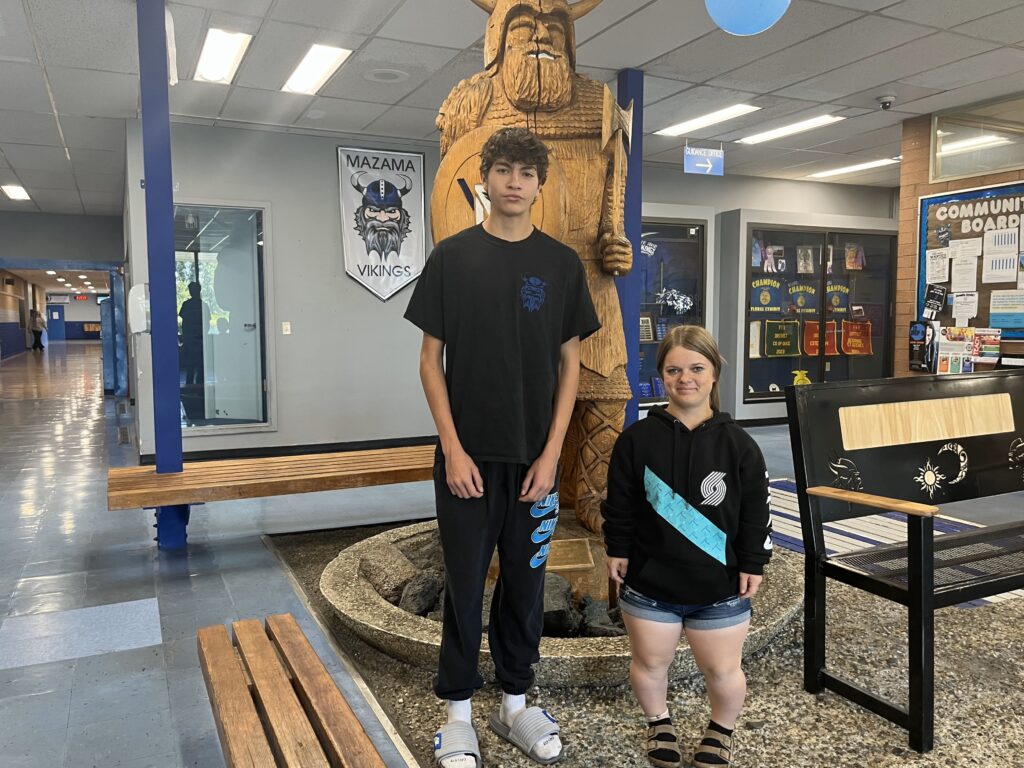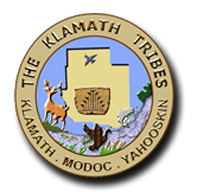FOR IMMEDIATE RELEASE
Date: June 20, 2023
Contact: Ken Smith, Public Relations Director
kenneth.smith@klamathtribes.com ; 541-783-2219 ext. 147
Download full .pdf Press Release
Mazama’s New “Welcome” Sign Includes Klamath Tribal Languages – A First for the School
CHILOQUIN, Ore. – When the students of Mazama High School return from their summer vacation, there will be a new welcome sign at the school, representing five languages, including Klamath, Modoc, and Yahooskin-Paiute, which will be a first for the school.
The idea for the Klamath Tribes’ languages to be on the sign was initiated by two Klamath tribal member seniors: Stormy Tecumseh and Nikishowda Pelletier. They approached the school administration to apply a portion of money from a senior school fundraiser to develop a project that would represent the diversity of students at the school. Mazama has 640 students and the largest population of Native American students in the Klamath County School District with 181 enrolled at the school this past year.
Mazama High School Vice Principal, Sergio Cisneros, assisted with the project, along with Mazama junior Nevaeh Felsinger and sophomore Trusten Jackson. With some brainstorming by all involved, it was decided that a “Welcome” sign could best represent the diversity of students at the school. For the greatest visibility, two signs would be placed next to the doorways at the entrances of the main office and athletic center.
Jackson and Felsinger said they had been discussing the idea for a new multilingual “Welcome” sign with their fellow students for more than a year.
“I think it’s really nice that we did this because of our native population here,” said Jackson. “I feel like we’re not really represented, and this would be a nice step up, just to show some recognition of the amount of people that are here who are Native American who are from that culture.”
“It was actually kind of a lot of pieces coming together to make this happen,” added Cisneros. “One was that we had some of our senior class students, the ones that graduated last week. So, they’re no longer here. But in part, it was those students who came and said we want to do a senior gift to our school that’s meaningful, that represents us and that’s going to leave a long-lasting impact. And one of the points of emphasis that we’ve had for this year was making our school inclusive and welcoming to all our student populations.”
Cisneros said some of the students who were part of the “Newcomer Program”, the non-English speaking students said they liked the idea for a multi-language “Welcome” sign, and how they could come together to make something special. “So, in brainstorming some ideas with these students, they said, you know, some of our signage that people see as soon as they come up to the school is dated, it’s not that well represented, and the language is just something that’s not meaningful or represents us well,” Cisneros said.
The school partnered with Impressions Design and Marketing in Klamath Falls to come up with new branding for the school, and the new “Welcome” sign. Two mock-up designs of the signs are currently displayed at the two entrances.
“In doing that, it was important for our students, and our staff, and our school community to be able to say, ‘we see you, we validate you’, and we want you to know that Mazama welcomes you as a place to be successful,” Cisneros said, “to be a part of our community, and that this is a place where, regardless of what walk of life you come from, what your background is, it’s somewhere where we can come together, and we can learn, and we can grow, we can be successful in this environment.”
Mazama High School Principal Jennifer Hawkins said equity and diversity is central to the school’s principles.
“You know, equity has been around as a buzzword for a long time,” Hawkins said. “But I think, really, we’re figuring out what that means and how that is represented in our school in all pieces that we do. If you look around at our signage at Mazama, it’s old, and it’s all English.
“I think our vision for Mazama is different than anything that’s been represented in the past. And, so, you will see that the language, even though it’s just on the front doors, you’ll see that start to be included throughout the building. We have Senate Bill 13 lessons out there that our staff makes sure they teach. It’s just those little incremental components that come in each year that make a little difference, but when you add them all up, the difference is large.”
Jackson said it was a big step for the school to develop the “Welcome” sign in multi-languages. “I think it would be helpful for every Native just to see that and it will make them happy, and it makes me happy,” he said. “I have felt that Native Americans have been underrepresented. Such a low percentage. So, I think it would speak a lot to that, just that we’re noticed. And it would mean a lot to me.”
Cisneros said the signs are a first step in creating an environment that’s inclusive, but also validates the school’s students, teaching them about their culture and language, and providing them with an opportunity to remain connected to their culture.
“I know that’s very important for students to be able to walk into places like schools, and see their culture, see their language, because then they feel seen, they feel invested in it,” he said. “And something that we as an administrative team believe in, is that students invest more when they feel like they’re being invested in. And, so, by doing the signage with the language that’s representative of them in their culture, and then potentially offering classes for them to learn the language, learn about their culture…and get them to invest more in themselves and in their communities and in their schools. Because that’s what we believe will build a thriving community as a whole.”
Cisneros added that it’s something the staff has been working on with Senate Bill 13, continuing to infuse in the students to learn about the area, their culture, and their language, so that they feel connected.
“For us, when you look at our students at risk,” Cisneros said, “and I’m talking about students of color, our Native population, non-English speaking, they’re the students who are more at risk of not finishing or graduating high school. And so, as a staff and as an administrative team, we see that, and we want to change that because it’s not that we’re happy, or our students are happy with those numbers. We want them to be here and be successful and graduate, so we can help them transition into the next phase of their life.”
Jackson said that the entire school is thankful to the seniors who took the initiative to leave a gift that will have a lasting impact. He addressed Nikishowda, in particular. “I just love that he’ll have this effect on the school,” he said. “I mean, everyone knows Niki. He’s a lovable person. He’s going to leave this on the school, and it’s going to be great. I’m going to remember it forever. I’m going to tell my kids about it.”

A mock-up of the new “Welcome” sign is displayed at the main office entrance of Mazama High School. (Photo by Ken Smith/KlamathTribes. Image is available for media use.)

Mazama High School junior Nevaeh Felsinger (right) and sophomore Trusten Jackson assisted in getting a new “Welcome” sign made to include Klamath tribal languages. (Photo by Ken Smith/Klamath Tribes).
###
About The Klamath Tribes
The Klamath Tribes primary mission is to “protect, preserve and enhance the spiritual, cultural and physical values and resources of the Klamath, Modoc and Yahooskin Peoples by maintaining the customs of our ancestors.” The heart of Tribal life is centered in the area of Chiloquin, Oregon and includes 12 Departments, Health Clinic, Childcare Center, Tribal Court, goos oLgi gowa Center, Research Station, and three tribal enterprises. The Klamath Tribes’ 12 departments facilitate service delivery to multiple aspects of tribal life, including health and fitness, education, economic development, social services, cultural preservation, natural resource protection and more. For more information visit https://klamathtribes.org/.





